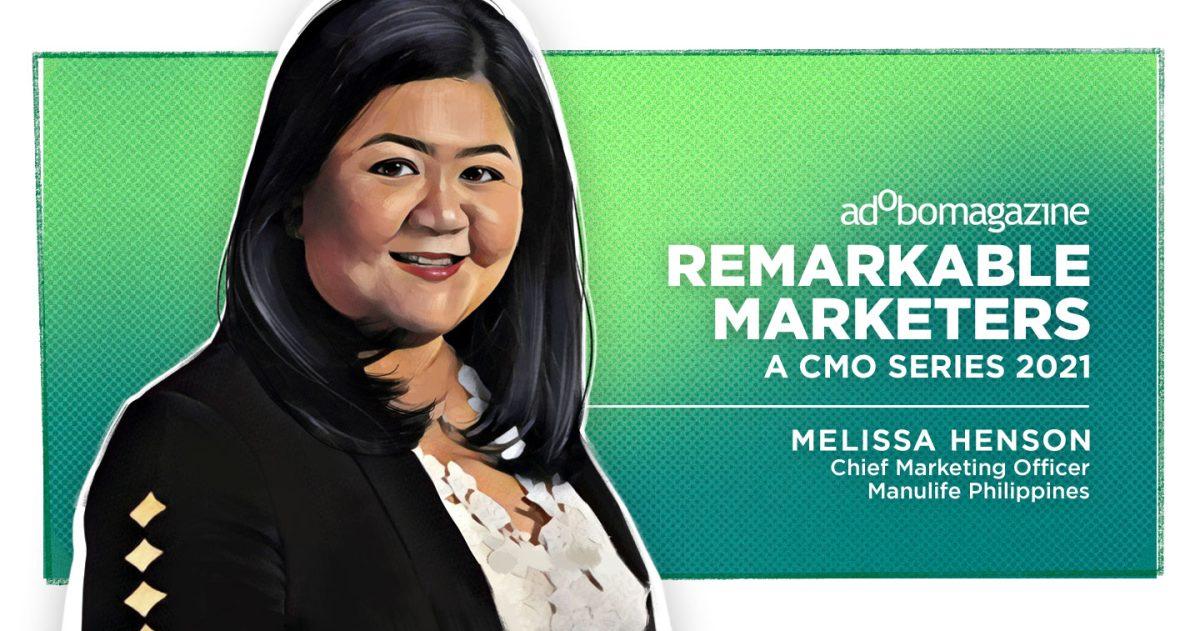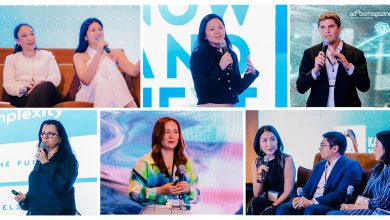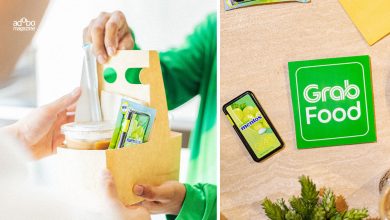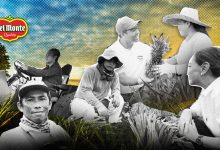MANILA, PHILIPPINES — The COVID-19 pandemic ushered disruption within the industry—yet the most remarkable marketers are the ones leading their brands with resilience and courage, as they rise above the times and usher innovation and creativity in their strategies and decision-making.
adobo Magazine presents Meet the Remarkable Marketers: A CMO Series 2021, where we feature some of the most fearless, agile, and exemplary brand leaders as they provide inspiration, insights, and key learnings that have shaped their business —from surpassing industry benchmarks and launching creatively effective campaigns, to initiating best practices as they navigated through uncertain times.
Melissa Henson is the Chief Marketing Officer of Manulife Philippines. Before joining Manulife in 2015, she had over 10 years of experience in consumer banking in the United States and the Philippines, leadership roles in branding, advertising and communications, customer acquisition and retention, and digital banking, after earning her MBA degree from Georgetown University and graduating cum laude with a Bachelor of Science degree in Psychology from Ateneo De Manila University.

Today, Melissa oversees Manulife’s growing portfolio of marketing and customer-related functions, which currently include branding, communications, community service, digital marketing & engagement, customer experience & insights, data analytics, and sales incentive & recognition activities. During her time with the company, she has also led product management & development, as well as customer-facing operations functions.
The Manulife CMO discusses with adobo how she and her team have managed to strengthen Manulife’s relevance during this period, and brought the brand closer to Filipinos’ lives.
What has been the most disruptive part of the pandemic cycle in your role as marketer and what did you have to immediately address to fortify your brand’s foothold in the market?
We had plans laid out for 2020 and we were just getting started when the pandemic hit. It rapidly caused shifts in day-to-day life and behaviors – for instance, working from home, minimizing trips out of the house, physical distancing. All these changes meant we had to very quickly rethink the way we do things.
Some examples of our observations, and the actions we took as a result – According to our 2020 Asia Care Survey, in the Philippines, digitalization has enabled more Filipinos to get access to financial services, with COVID-19 reinforcing the value of digital tools and services to manage their daily lifestyle. In response to this, we have continuously enhanced our customer self-service portal Manulife Online, so our customers can conduct smooth and hassle-free transactions, manage their policies, and make cashless payments without having to leave their homes.
We also learned through consumer surveys that the pandemic fueled Filipinos’ appetite for insurance, with 77% intending to buy insurance. However, restrictions on mobility and face-to-face interactions made access more difficult. With this in mind, we leveraged our Electronic Point of Sale (ePOS) platform to equip our insurance advisors with tools to conduct financial consultations and serve insurance needs virtually, without the need for in-person meetings.
In pre-pandemic times, our customer engagement activities happened face to face through regular market briefings and customer appreciation nights to inform and educate our customers. These events are no longer possible in the time of COVID-19. We also recognized that the knowledge and information needed during this time is a bit different, as there’s a demand for guidance on navigating the current environment and adapting to new norms. So, we launched a series of free Manulife webinars to help address some of Filipinos’ most pressing concerns on health, mental wellness, and finances. We invited experts from a variety of fields to provide insights into topics that are top of mind for Filipinos.
In terms of marketing budgets and brand investments, what were the shifts you made in terms of marketing efforts and media channels to reach your digitally connected, at-home customers?
We aim to be the most digital and customer-centric player in our industry. This means being there for our customers where and when they need us. In the past year and a half, we have seen more Filipinos embrace digital channels, with 79% of Filipinos now expressing a preference for online services, such as online chats and online payment, and using online tools for their activities, like reading news and socialization.
From a brand and marketing perspective, because more Filipinos now consume content via digital platforms, we have increased our online presence through our digital films. We have launched three films this year (), and have introduced a new video Manulife Every Day Better series on our YouTube channel. It’s all about finding new ways to add value to Filipinos, as we continue to navigate our still-evolving normal.
https://youtu.be/7PopgdAWZKc
From a customer service perspective, it’s important to us to provide customers the tools and services they need to manage their policies from the safety of their homes, so they can be reassured that they have the insurance protection they need when it matters the most. Manulife was among the first to announce premium due date extensions for customers, so they could keep their policy active despite enhanced community quarantine (ECQ). We have also enabled more secure and convenient payment channels, so the lack of physical mobility does not prevent them from staying protected. Finally, we have made enhancements to Manulife Online — besides real-time updating of personal information and tracking fund value for investment-linked plans, customers can download premium notices and variable life statements of account.
We have also worked to actively support our community during these challenging times.
Early in the pandemic, when restrictions were tightest, we all experienced the heroism of delivery riders, who shuttled necessities and kept the economy going, while we were all confined at home. To show our appreciation and support for this unique set of frontliners, we provided 85,000 two-wheel delivery riders with free 90-day accident insurance coverage.
The shift to distance learning provided us with an opportunity to revisit our financial literacy program Peso Smart. What started in 2017 as a weekly face-to-face classroom program evolved into Peso Smart x RecoveREADS, a distance learning program, where over 100 students from Pasig City were given Peso Smart learning kits that teach children the basics of saving, budgeting, and investing. Peso Smart now also includes storybooks Manny and Liv, Yaman Bayan and Super Buds, which aim to make learning smart money habits more fun, and to promote meaningful family interactions as parents teach their kids at home.
In May 2021, Manulife also donated CAD $250K to support COVID‐19 relief efforts in five countries in Asia heavily impacted by the pandemic: India, Cambodia, Indonesia, Malaysia, and the Philippines. The company’s donation went to Project HOPE, an international health and humanitarian organization, which assisted with on-ground relief in these countries, such as providing much-needed supplies for healthcare facilities including oxygen, ICU beds, PPE kits, and other medical supplies.
To realize your need to manage this cataclysmic shift, what do you expect from your partner advertising, media, PR agencies and how does this differ from the pre-pandemic period? How are you structuring for the uncertainties ahead?
Before and during the pandemic, my ask of our partners has been the same – to help differentiate our brand through relevant and timely content, and meaningful interactions. The product has not changed – life insurance remains to be a product that is not very highly nuanced, so it is important that our messages are strong and relatable, so we can cut through the noise and bring our mission to life.
If anything, we demand more now, as we have been generating content at a visibly faster pace, and across more touchpoints. Also, I ask for sensitivity. We are in unique times, and it is important that our material is sensitive to the current plight and experiences of Filipinos.
Intelligence, insights, and real-time data gathering is essential to your marketing decisions, more so than any other time. What are you on the lookout for?
We are in a situation that continues to evolve, and, as a result, consumer attitudes and behaviors will continue to evolve as well. This is why we have to put a lot of focus in listening to consumer sentiments during this time, and an even greater focus on taking action, based on what we hear.
We’ve conducted several studies in the past 18 months, each of which has highlighted opportunities for us to better serve our customers and the community.
In Manulife’s Asia Care 2020 Survey, we found that COVID-19 fueled Filipinos’ appetite for insurance; however, many had concerns about financial security and the long-term economic impacts of the pandemic. In response, we redesigned and reintroduced our term insurance plans (Yearly Renewable Term and React5) so we can make our products more accessible to more Filipinos.
Through another study, Understanding Filipino Sentiments Toward Health and Critical Illness, we learned that many Filipinos still face barriers to embracing better financial and lifestyle habits. Particularly, Filipinos feel that they are financially unprepared for critical illness. Fueled by insights gained from this study, we introduced HealthFlex, a flexible and customizable health insurance plan, which lets you choose and pay only for the health coverage you need.
In addition, key findings of Manulife’s Asia Care Survey 2021 revealed that Filipinos take more control of their health and finance through insurance and retirement planning, as the country comes to term with the impact of the pandemic. This highlighted a need for more retirement solutions, which led us to launch new Unit Investment Trust Funds (UITFs) for investors, plus expanded fund options for our investment-linked insurance plans.
Lastly, our most recent study, “Know Your Ys and Zs: A closer look at the financial and mental well-being of Filipino millennials and Generation Z in the time of COVID-19,” revealed that the pandemic has heightened the financial and mental health challenges of Filipino millennials and Gen Zs. As they strive to navigate the new realities brought by COVID-19, they are taking proactive steps toward achieving financial security and mental wellness. These insights inspired our Every day better series on YouTube where we share life hacks to help navigate everyday challenges and concerns. We also introduced My Goal Planner on our website to help Filipinos build a plan toward achieving their goals. For Gen Z, we are expanding Peso Smart for university students, a three-week program that teaches university-level students about financial planning, growing their money, and business resilience.
This is what we are on the lookout for – how we can make every day better for Filipinos, especially during this time of great uncertainty.
What are your thoughts on the surge of brand purpose and cause-related advertising to an often-skeptical consumer?
While the pandemic has kept us physically apart, I think the collective experience has made us feel part of a greater whole and has awakened the altruist within many. I think this is wonderful, because, in these situations, it is important that we find ways to help and lift each other up. Brands play a role in that as well.
That said, I think acts of altruism need to be true to a brand’s mission and purpose, so that it can be sustained even beyond the pandemic, and make lasting impact on the community.
This is why most of our CSR focus locally has remained on Peso Smart – a program that we were already running before the pandemic, but have been able to expand in pandemic times. This program is true to our mission and allows us to bring our values to life. It can make a long-term impact to the children we teach, as well as their families. We believe that the new model we have developed will remain beyond the pandemic, and will enable us to reach more children with this program.
Do share some of the campaigns and case studies to showcase your brand efforts that exemplify creative effectiveness.
Goodbye, Hello – Launched in January 2021, this New Year-themed campaign features the story of Miguel and his Lola Nora, as they prepare to take on 2021, following the challenges they faced in the previous year. The film touches on the importance of learning new things, and turning difficulties into opportunities. As we’ve discovered through our studies, Filipinos’ values and priorities have changed because of the pandemic. So, we wanted to focus on what is truly essential — to make our loved ones feel cherished and protected. The film garnered great social media attention – 10,041,388 post engagements – achieving 3,000% of our total campaign target. It also helped us generate a significant number of leads.
Now more than ever, we are determined to be with our customers in every step of their financial journey, helping them thrive as they power through the new normal. We want to assure them that: when life stops, we keep going with you.
Imagine – Launched in May 2021, Manulife Investment Management’s Imagine tells the story of two aspiring actors who, upon recounting their lives, wondered what they would do if they became millionaires, and realized that time spent wondering can be time spent earning. We recognize that now more than ever, investments are even more critical to help fulfill financial aspirations. The film got nearly 4 million views and 1.1 million post engagements, and also helped the business in our lead generation efforts.
We aim to reach more Filipinos to show them that investing can be easy, exciting, and accessible, so they can enjoy their present while securing their future.
What are the greatest work and life lessons you have learned from the past year?
The pandemic has made me realize the importance of being mindful of how my attitude affects those around me, focusing on the things I can control, unplugging to take time away from stressors, and leaning on my faith. Having an attitude of gratitude is also key – focusing on the good and the things we can be thankful for goes a long way.
How do you foresee 2022 and what do you anticipate will be the emerging trends? Do you feel ready to take it on?
They say it takes 21 days for a habit to form, and we are now at almost 600 days into the pandemic. That said, I think a lot of the changes in consumer behavior that we have seen in the past 18 months will continue into 2022. According to our health study, Filipinos formed new “sticky” habits since the COVID-19 pandemic — finding ways to be more physically healthy, keeping track of mental wellness, and reviewing personal finance more often — and these habits have stuck and are now part of their new normal routines.
I wish I had a crystal ball that would predict further changes, but I don’t, so in the absence of that, I think my role as a marketing leader is to first, build resilience and a culture of continuous learning among my team, so we can quickly adapt to any changes; and second, keep my pulse on consumer sentiments, so we can identify how we can best address evolving customer needs.
On wellness, how do you take care of yourself and find that white space in this all-consuming, digitally-connected new world? Give us a few tips.
The pandemic has made me much more conscious of overall wellness, and the importance of balance. Here are some of the things that work for me:
- Setting boundaries for myself – The pandemic has blurred the lines between work and life, because WFH has eliminated the physical separation between work and home. I have had to be much more disciplined about creating this boundary for myself. This has meant creating beginning and end-of-day rituals that physically mark the beginning and end of my work hours. I’m also more conscious about unplugging and not checking my work devices round-the-clock. As a result, I spend much less time on them now than I did pre-pandemic.
- Making sure I have offline activities – I still read paper books, and make sure I start each day by reading. I’ve probably read more books in the past 18 months than the past 10 years. I also cook for my family on weekends, and challenge myself to try new cuisines and recipes regularly. This gives me something to plan that is not work-related, as well as an offline activity where I use my hands and exercise other skills.
- Staying connected – Virtual meetups and catch-ups with friends have been a great way to both keep in touch, as well as break the everyday monotony of WFH. This helps renew my spirit and keeps me energized.
- Moving more – After a few failed starts, in the past few months, I’ve finally started and sustained a daily workout. I started with 20 mins/day, and I continue to work my way up, as my endurance improves.
- Faith and prayer – These help keep me grounded and hopeful during these challenging and complicated times.
Paying it forward has been a great way to keep myself well during this time. I’ve been mentoring and coaching a lot more in the past 18 months, and it has been very enriching. I think I learn as much, if not more than, the individuals I have been helping – mentoring and coaching conversations give me new perspectives, and help me focus my energy on the positive.
Related articles:








